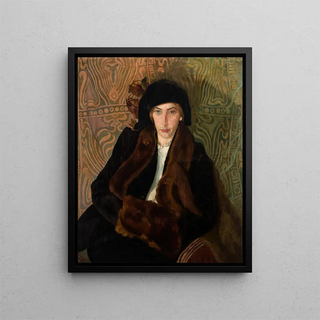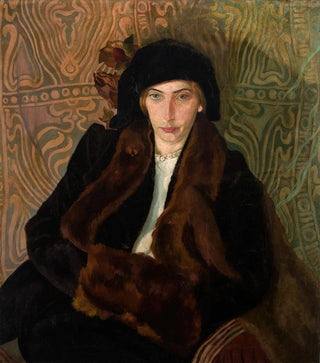Art print | Portrait of Eugenia Dunin Borkowska - Stanisław Ignacy Witkiewicz


View from behind

Frame (optional)
Portrait of Eugenia Dunin Borkowska - Stanisław Ignacy Witkiewicz – Captivating Introduction
The "Portrait of Eugenia Dunin Borkowska," created by Stanisław Ignacy Witkiewicz, is a work that transcends the simple frame of painting to become a true exploration of the human soul. This portrait, charged with emotion and intensity, invites us to delve into the intimate universe of its model, a woman whose gaze seems to tell a story far beyond words. The composition, both delicate and powerful, captures attention and provokes reflection on beauty, fragility, and the depth of human relationships.
Style and uniqueness of the work
Witkiewicz, an emblematic figure of the early 20th century, stands out for his ability to blend tradition and modernity. In this portrait, he uses vibrant colors and bold shapes to create a unique atmosphere. Eugenia's face is rendered with striking precision; every detail, from the texture of her skin to the sparkle in her eyes, is meticulously crafted. The artist's technique, which combines Impressionism and Expressionism, allows for the transmission of a palpable emotion. The brushstrokes, both fluid and dynamic, breathe life into the canvas, while the background, subtly blurred, highlights the central figure. This portrait does not merely depict a person; it captures an essence, an atmosphere that invites introspection.
The artist and his influence
Stanisław Ignacy Witkiewicz, also known as Witkacy, is a complex personality, both painter, playwright, and philosopher. His work reflects his reflections on the human condition and art. By incorporating psychological and symbolic elements into his portraits, he managed to create a style that is uniquely his own, influencing many contemporary artists. Witkiewicz often questioned the nature of reality and identity, and this is evident in his works. The "Portrait of Eugenia Dunin Borkowska" is a perfect example of this quest, where the subject is both a person and a symbol of the era, a representation of femininity and complexity.

Matte finish

View from behind

Frame (optional)
Portrait of Eugenia Dunin Borkowska - Stanisław Ignacy Witkiewicz – Captivating Introduction
The "Portrait of Eugenia Dunin Borkowska," created by Stanisław Ignacy Witkiewicz, is a work that transcends the simple frame of painting to become a true exploration of the human soul. This portrait, charged with emotion and intensity, invites us to delve into the intimate universe of its model, a woman whose gaze seems to tell a story far beyond words. The composition, both delicate and powerful, captures attention and provokes reflection on beauty, fragility, and the depth of human relationships.
Style and uniqueness of the work
Witkiewicz, an emblematic figure of the early 20th century, stands out for his ability to blend tradition and modernity. In this portrait, he uses vibrant colors and bold shapes to create a unique atmosphere. Eugenia's face is rendered with striking precision; every detail, from the texture of her skin to the sparkle in her eyes, is meticulously crafted. The artist's technique, which combines Impressionism and Expressionism, allows for the transmission of a palpable emotion. The brushstrokes, both fluid and dynamic, breathe life into the canvas, while the background, subtly blurred, highlights the central figure. This portrait does not merely depict a person; it captures an essence, an atmosphere that invites introspection.
The artist and his influence
Stanisław Ignacy Witkiewicz, also known as Witkacy, is a complex personality, both painter, playwright, and philosopher. His work reflects his reflections on the human condition and art. By incorporating psychological and symbolic elements into his portraits, he managed to create a style that is uniquely his own, influencing many contemporary artists. Witkiewicz often questioned the nature of reality and identity, and this is evident in his works. The "Portrait of Eugenia Dunin Borkowska" is a perfect example of this quest, where the subject is both a person and a symbol of the era, a representation of femininity and complexity.






